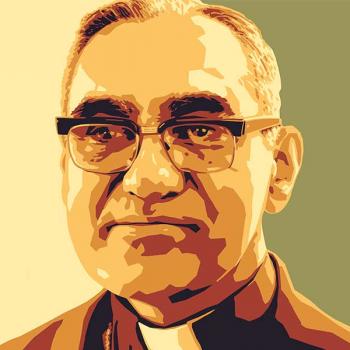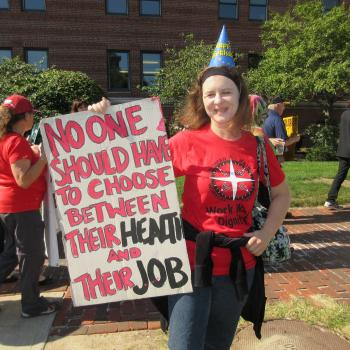Friar Tuck is an interesting character in the legends of Robin Hood. It appears he was not one of the original members of Robin’s Merry Men, but was, with Maid Marian, a later addition to the legend. It also appears that there was some brigand who called himself Friar Tuck, and, much later, this brigand was to become a part of the Robin Hood legends. How late, one might ask? The brigand lived in the fifteenth century:
The name appears in two royal writs of 1417 and a further letter of 1429. The writs of 1417 record that a man called Friar Tuck had gathered around him a band of armed malefactors who had committed murders and robberies and threatened the peaceful existence of the men of Sussex and Surrey, and had entered the warrens and chases of the two counties to hunt without licence, burn the lodges of the foresters and warreners and so menace them in life and limb that they could no longer carry on the king’s business. [1]
While the real “Friar Tuck” was a man named Robert Stafford, it is not too hard to understand why Robin Hood’s men would find a suitable home for a “Friar Tuck.” Robin Hood, in his initial phases, was quite religious, indeed, he was devoted to the Virgin Mary. Though Robin Hood was capable of great violence, he was also seen as a figure representing the revolt which was needed when the law became unjust. Theologically, it is said an unjust law is no law; Robin Hood shows us that when injustices are demanded by the law, the righteous are to become outlaws and work for the overthrow of such injustices. Ordinary people, trying to make ends meet, need heroes if they are to survive. Having the persona of a Friar Tuck added to the Robin Hood legends gives religious support to this view. Friar Tuck, though often a figure for comic relief, shows both the human frailty of the religious (they have their vices, too) and yet the potential nobility of those who live out the religious life. In this way, Friar Tuck is able to represent the Church and show how the Church, in her best function, is able to support the cause of justice, even when other factions of the Church stand with the oppressors of the people (the legends of Robin Hood have Robin face a great number of wicked clergy). It also serves to remind us of the all-too-human character of those who seek to do good, even in religious life. Though they have great ideals, though they might even be holy, they must not be seen outside of the light of their humanity, turned into robots. Human frailty and imperfection makes their heroic work even more extraordinary.
It is interesting to see that in the Chinese classic Outlaws of the Marsh, we have a Friar Tuck like figure in the Buddhist Monk, Sagacious Lu. Originally a well-trained soldier, Lu became a rather unconventional Buddhist monk (eating meat, drinking alcohol, engaging in violence) who had the destiny of becoming a Buddha by the end of his life. Once again, we see that when injustice prevails, society needs outlaws to rise up and demand the re-establishment of righteousness in society. Once again, religious support is seen as needed in making this declaration, and Sagacious Lu, by being a Buddha, is shown as representing the pragmatic way the truth works in the world to save it (a form of skillful means). A Buddha is interested in saving people, in saving society; Sagacious Lu, by being one so close to Buddhahood that he can become enlightened at the end of his life, shows that such skillful means can make a great spiritual being appear as one of the lowly criminals in order to bring about such salvation. With Outlaws of the Marsh, though many of the outlaws are mostly noble in spirit, many of them became outlaws through some evil action they committed. They were often forced into a bad situation by the injustices around them, showing how evil in society can and does contaminate those who seek to do good. Even heroes need forgiveness. Once again the frailty of the best among us allows us to appreciate their heroic virtues while recognizing that they are truly one of us and we can be one of them if we wish.
When we look to the lives of the saints, we should not only look to their great virtues, but to what makes them human. It is easy to see the vices in someone and to use it to denounce the good they want to do. But the saints show us, God can work with men and women with vices and make them holy. St Jerome was a great man, but he was often a petty man, a man of great wrath. St Vladimir was a warlord before he was a Christian monarch, and his barbaric past was always a part of him as he brought Rus into Christendom. King David’s sins did not prevent him from being a friend of God and an exemplar of the messianic king. Samson’s lust nearly got the best of him, and yet he was able to join himself with God to save Israel. Legends of outlaws who work for justice, be it Robin Hood, or Song Jiang in China, take this truth and apply it to ordinary life. When injustice rules, the good will be outlaws; the good will be men and women with faults, faults which officials might use to denounce them, but faults which do not diminish the good which they seek for society as a whole. The Friar Tucks and Sagacious Lus remind us that true religion seeks justice, blessing those who seek it, a blessing which is necessary if the cause for justice is to be fulfilled. While the real Friar Tuck was a robber who did no good, the name struck a chord, and reminded the English that the nobility of Robin Hood would forever be lacking if there were no religious support for his cause. Friar Tuck, born of the real world, was to join in with legend, representing forever the synergy of work and grace needed for true justice to prevail.
[1] J.C. Holt, Robin Hood (London: Thames and Hudson, 1982), 58-9.











